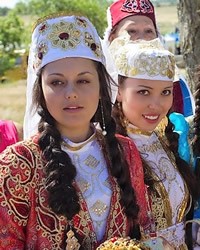Throughout history, Armenia has been a battlefield for many invaders and contending empires, and a bridge for many cultures and civilizations. During the past 2,700 years, Armenia has been conquered by the Persian Empire, Alexander the Great, the Roman Empire, the Byzantines, Arabs, Mongols, Tatars, Ottomans, Persians, and Russians. Armenian kingdoms, principalities, and even a short-lived empire (95-55 B.C.) managed to survive and thrive for some 1,700 years. Under various kings and princes, the Armenians developed a sophisticated culture, an original architecture, and their own alphabet.The 1905 Russian revolution and the 1908 Young Turk revolution raised the hopes of the Armenians for reform, and an opportunity to build a homeland in historical Armenia. These hopes were dashed as the Ottoman and the Russian Empires fought each other during World War I. A dark hour of Armenian history is the Armenian genocide, which started on April 24, 1915. Some 1,750,000 Armenians were deported into Syria and Mesopotamia by the Ottoman authorities. Subject to famine, disease, and systematic massacres, most of them perished. This "ethnic cleansing" of the Armenians from their historical homeland led Raphael Lemkin, the father of the Genocide Treaty, to coin the new term "genocide" in the 1930s to describe the historical plight of the Assyrians and the Armenians as subjects of the first genocide of the 20th century. Armenia gained independence on September 23, 1991.Today, there are several million Armenians worldwide. Significant numbers are located in Armenia and the United States of America. Major diaspora centers of the Middle East are Iran, Syria and Lebanon. There are also Armenian communities in some of the European and Latin American countries, such as Brazil.Armenians have settled in Brazil since the 1890s. However, many of the current population dates to the 19th century when Armenians began to move to Brazil due to daily massacre and persecution of the Armenians in the Ottoman Empire. Most of the Armenian population in Brazil lives in Sao Paulo, Rio de Janeiro, Porto Alegre, and Fortaleza.
With a large population of Armenians calling Brazil home, the community has contributed a memorial ‘Armenian Square' in Sao Jose to commemorate the victims of the genocide as well as the Armenian contributions to the Brazilian community.Armenians are known for their hand-crafted crosses made from stone named ‘Khachkar' – in which one is also displayed in the park at Sao Paulo. Historically, Armenians established themselves in the textile trade, shoemaking, and metalwork – notably businesses like these are famously known as Armenian-founded and known in Brazil. Over the generations, they expanded their presence in other work sectors such as construction, finance, medicine, arts, and politics.Like the rest of their global diaspora, the Brazilian–Armenian diaspora has community organizations that actively host cultural programs, concerts to celebrate their dance and music, and commemorations. Alongside this, the Armenian community has also opened formal daily schools and churches that allow the Armenian community to be closely knit. The community is comprised of different Christian denominations and churches: Catholic, Armenian Apostolic, and Evangelical. Although Armenians are away from their motherland, they have not failed to create a ‘motherland' with the community groups, churches, schools, and activities held to portray their heritage and culture in Brazil. Brazil holds strong ties with Armenians through community activism, aiding institutions in Armenia. The Brazil Federal Senate recognized the Armenian Genocide in 2015 and declared it an official day of genocide remembrance.
In 301 AD, during the rule of King Dirtad III, Armenia became the world's first Christian nation. A Christian monk, commonly known as Krikor Lusavorich or St. Gregory the Illuminator, cured the King of a disease. After this event, King Dirtad III was baptized and accepted Christianity as Armenia's official state religion. Before this, two disciples had brought Christianity to Armenia, St. Thaddeus and St. Bartholomew.Spiritually, Armenians are still Christian, but their faith in Christ has often taken the back seat to nationalism or a faith in their heritage. Every generation needs a fresh work of the Holy Spirit to move them to full devotion to Jesus Christ.
Armenians need the Holy Spirit to move in their families and their churches so they can enjoy the abundant life that only Jesus offers.
Pray for the Armenians in Brazil to be salt and light to those who don't know the only Savior.Pray for spiritual peace; this is what Armenia needs most of all.Pray that God would bring revelation of Christianity as a spiritual relationship, and that Armenians would realize they can have joy and peace as they follow the Lord.Pray for their businesses to flourish as a testimony of God's power and goodness.Pray for the Armenians to glorify God for the global support they receive from other nations.Pray that the Armenians of Brazil will be faithful in serving Christ.
Scripture Prayers for the Armenian in Brazil.
Middle East Resourceshttps://en.wikipedia.org/wiki/Armenian_Brazilianshttps://www.asbarez.com/the-armenian-saga-continues-in-brazil/https://www.armeniapedia.org/wiki/Brazilhttps://hyetert.org/2012/05/25/armenians-in-brazil/http://diaspora.gov.am/en/pages/5/brazilhttps://brazil.mfa.am/en/community-overviewhttps://www.armenianclub.com/2009/12/12/armenians-found-in-every-major-activity-in-brazilian-life-brazilianhttps://anca.org/armenian-genocide/recognition/international/brazil
| Profile Source: Joshua Project |












